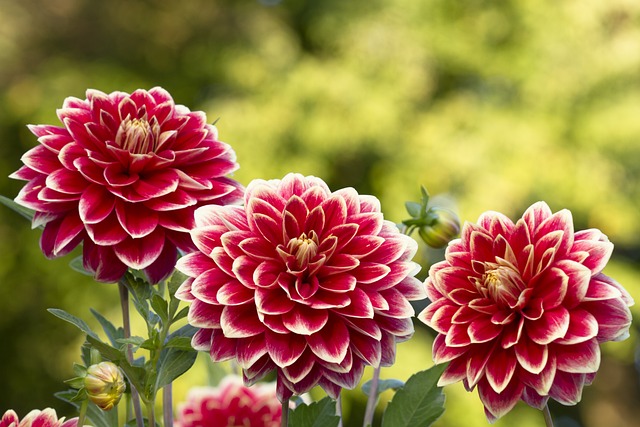Dahlias are stunning, versatile flowers that can transform any garden with their vibrant colors and intricate blooms. Growing dahlias from tubers is a popular method that ensures robust plants and spectacular flowers. This comprehensive guide will cover everything you need to know about planting dahlia tubers, including how to grow them at home, in pots, and without green sprouts. Additionally, we’ll touch on purple peonies, their blooming cycles, and the dahlia flower season.

Understanding Dahlia Tubers
Dahlia tubers are the underground storage organs of the dahlia plant. They store nutrients and energy to help the plant survive winter and regrow in the spring. Each tuber has eyes or growth points from which new stems will emerge.
How to Plant Dahlia Tubers
Selecting Tubers
Choose healthy, firm tubers with visible eyes. Avoid any that are soft, shriveled, or moldy. Varieties range from small pompons to large dinner-plate dahlias, offering a wide array of colors and shapes.
Preparing the Soil
Dahlias thrive in well-drained, fertile soil with a pH between 6.0 and 7.5. Amend your garden soil with compost or well-rotted manure to enhance its fertility and drainage.
Planting Steps
1. Timing: Plant dahlia tubers in the spring after the last frost when the soil has warmed to at least 60°F (15°C).
2. Location: Choose a sunny spot that receives at least 6-8 hours of direct sunlight daily.
3. Planting Depth: Dig a hole 6-8 inches deep. Lay the tuber horizontally with the eyes facing up, then cover it with 2-3 inches of soil. As the plant grows, fill in the remaining soil.
4. Spacing: Space tubers 18-24 inches apart, depending on the variety, to allow for adequate air circulation and growth.
Watering
Water thoroughly after planting and keep the soil consistently moist but not waterlogged. Once shoots appear, water deeply once or twice a week, depending on weather conditions.
Staking
Tall dahlia varieties may require staking to support their heavy blooms. Install stakes at planting time to avoid damaging the tubers later.

How to Grow Dahlia Tubers at Home
Indoor Starting
Starting dahlias indoors can give them a head start, especially in regions with shorter growing seasons.
1. Containers: Use pots or trays with drainage holes and fill them with a well-draining potting mix.
2. Planting: Plant the tubers 1-2 inches deep and water lightly.
3. Light: Place the containers in a warm, sunny location or under grow lights.
4. Transplanting: Once the danger of frost has passed and the soil has warmed, transplant the dahlias into your garden.

How to Grow Dahlia Tubers in a Pot
Choosing a Container
Select a pot with a diameter of at least 12 inches and good drainage holes. Larger varieties may require even bigger containers.
Soil Mix
Use a high-quality potting mix with good drainage. Adding perlite or vermiculite can improve aeration and prevent waterlogging.
Planting Steps
1. Depth: Plant the tuber 4-6 inches deep with the eyes facing up.
2. Watering: Water thoroughly after planting and maintain consistent moisture.
3. Light: Place the pot in a sunny location with at least 6-8 hours of sunlight daily.
Care
1. Fertilizing: Feed potted dahlias with a balanced, water-soluble fertilizer every 4-6 weeks.
2. Pruning: Pinch off the top growth when the plant is about 12 inches tall to encourage bushier growth and more blooms.
How to Plant Dahlia Tubers Without Green Sprouts
Dahlia tubers without green sprouts can still be successfully planted by following these steps:
1. Inspection: Ensure the tuber is firm and has eyes, even if they haven’t sprouted yet.
2. Pre-Soaking: Soak the tuber in lukewarm water for a few hours before planting to encourage hydration.
3. Planting: Plant as usual, ensuring the eyes are facing upwards. Cover with soil and water lightly.

Dahlia Flower Season
Dahlias typically bloom from mid-summer to the first frost in autumn. The flowering season can vary based on your climate and the specific variety. Regular deadheading (removing spent flowers) can encourage continuous blooming throughout the season.
Purple Peonies: A Complementary Garden Addition
Growing Conditions
Peonies prefer well-drained, fertile soil with a slightly acidic to neutral pH (6.5-7.0). They need full sun to partial shade and are best planted in the fall or early spring.
Planting
1. Depth: Plant peony roots 2 inches deep, with the eyes facing upwards.
2. Spacing: Space plants 3-4 feet apart to allow for adequate air circulation and growth.
Care
1. Watering: Water peonies regularly, especially during dry periods.
2. Fertilizing: Feed with a balanced fertilizer in early spring and again after blooming.
Do Peonies Bloom More Than Once?
Peonies generally bloom once per season, typically in late spring to early summer. The blooming period lasts for about 7-10 days, depending on the variety and weather conditions. Regular maintenance and proper care can ensure healthy blooms year after year.

Conclusion
Growing dahlia tubers is a rewarding gardening endeavor that brings vibrant colors and stunning blooms to your garden. Whether you’re planting in the ground, in pots, or even without visible sprouts, following the proper steps will ensure a successful growing season. Additionally, incorporating complementary flowers like purple peonies can enhance the overall beauty of your garden. With this comprehensive guide, you’re well-equipped to cultivate and enjoy these gorgeous flowers. Happy gardening!

